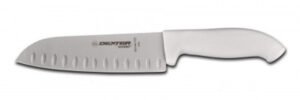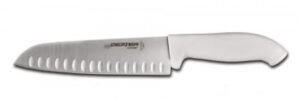HOW TO CHOOSE THE BEST SANTOKU KNIFE

Blade
Santoku knives are known for their powerful strength, their razor sharp edge, their thin blade, and their Granton edge. First we will discuss blade strength and why it is so important for a santoku knife. Since santoku stands for “three virtues,” which in this case is slicing, dicing, and mincing, you want a strong blade that won’t bend when you chop- the straightest cut is most desirable and gets the job done quickly and efficiently. You’ll want to shop for a high-carbon steel blade (like our santoku knives listed below) which is resistant to staining and rusting, and will hold a sharp edge long after it’s refined. Also, don’t let the extremely thin blade on a santoku knife fool you- this blade has no flex so you can cut confidently. If your santoku blade is flexible, it needs to be replaced with a higher quality steel blade. The thin stiff blade ensures you only need to make one quick straight chop- this speeds up the process of cutting and lets you make paper thin slices. Lastly, we will discuss the benefits of the Granton edge, which are the oval divots along the blade’s edge. The Granton edge is one of the best features on a santoku knife, so make sure you don’t miss out on it the next time you’re shopping. These divots ensure sticky foods like cheese, fish, and raw poultry don’t stick to your blade. Instead, the Granton edge creates tiny air pockets between the blade and the food, releasing it beautifully once it’s cut.
Length
The lengths of santoku knives range from 5 to 7 inches, most commonly. A wonderful feature of the santoku is its light weight, so your hand and wrist don’t fatigue with big jobs. Keeping the santoku within the 5 to 7 inch range will ensure you don’t purchase a santoku that will do the very opposite of what it’s supposed to- cause you fatigue. Of course, the size of foods you’re cutting will determine the size of blade you’ll want in your kitchen. Consider a 5 inch blade if you commonly cut small veggies, fruits, and meats. On the other hand, if you’re cutting large fish, chicken breasts, cheeses, etc., we recommend a 7 inch blade. The larger your blade is, the more universal it will be in the kitchen, but our job is to help you find the most reasonable size to fit your specific needs.
Handle
Many handles on the santoku knife are traditionally made of wood for an exceptionally balanced knife. The light weight of the knife itself lets you cut comfortably with a wood handle, and you won’t have to worry about throwing off your knife’s balance with an ill-matched handle. On the other hand, a light weight rubber handle will also provide balance and added comfort. In the end, it is up to personal preference and whether or not you need extra grip and comfort to cut confidently.
Shape
The traditional shape of the santoku knife features a long blade so you can easily pick up your freshly minced or diced food and throw it into a bowl, skillet or wok. This will speed up your cooking even more, as if using the santoku wans’t already fast and painless enough? You’ll also notice santoku knives commonly have a flat tip called a sheepsfoot blade, rather than a pointed tip like a chef knife. This design is so you can have a straight blade edge, with a small amount of curve, so you have as much blade surface area as possible to make your cuts. The sheepsfoot blade makes this knife exceptional for making long cuts in one swift chop, as well as letting you use the entire blade’s surface rather than just the middle like with a chef knife.
BEST SANTOKU KNIVES

The Dexter Russell SofGrip 7″ Duo-Edge Santoku Knife, or the knife of “three virtues,” will assist you in slicing, dicing, and mincing your favorite fishes, fruits, and vegetables. Its straight edge gives you a large cutting surface for quick dicing and mincing. When you’re done chopping, gather all of your freshly diced or minced food and throw it into a bowl or a sizzling pan with ease. The santoku is not just great for raw fruits, veggies or cheeses. This knife will become your new sashimi best friend, and remember, it releases any sticky raw meats or other foods with its granton edge. We’ll stop boasting now, and let you discover for yourself the numerous ways this knife will benefit your kitchen. On top of all that, the SofGrip handle on this knife will ensure you get the most grip and comfort possible, so your hand won’t tire.
Dexter Russell SofGrip 7″ Duo-Edge Santoku Knife- Buy Here

The Dexter Russell SofGrip 9″ Duo-Edge Santoku Knife is larger than the average santoku knife. However, it serves its purpose if you need to dice a very large amount of vegetables, or a large piece of fish or chicken. You will not have as much control as you would with a smaller santoku, but you will be able to slice a large amount of food in a short amount of time. Although bigger in size, this santoku still has a light feel to it, so it will offer more control than a traditional chef’s knife. Paired with the SofGrip handle, your hand will stay comfortable and won’t tire with big cutting jobs.
Dexter Russell SofGrip 9″ Duo-Edge Santoku Knife- Buy Here
Back to Home Page